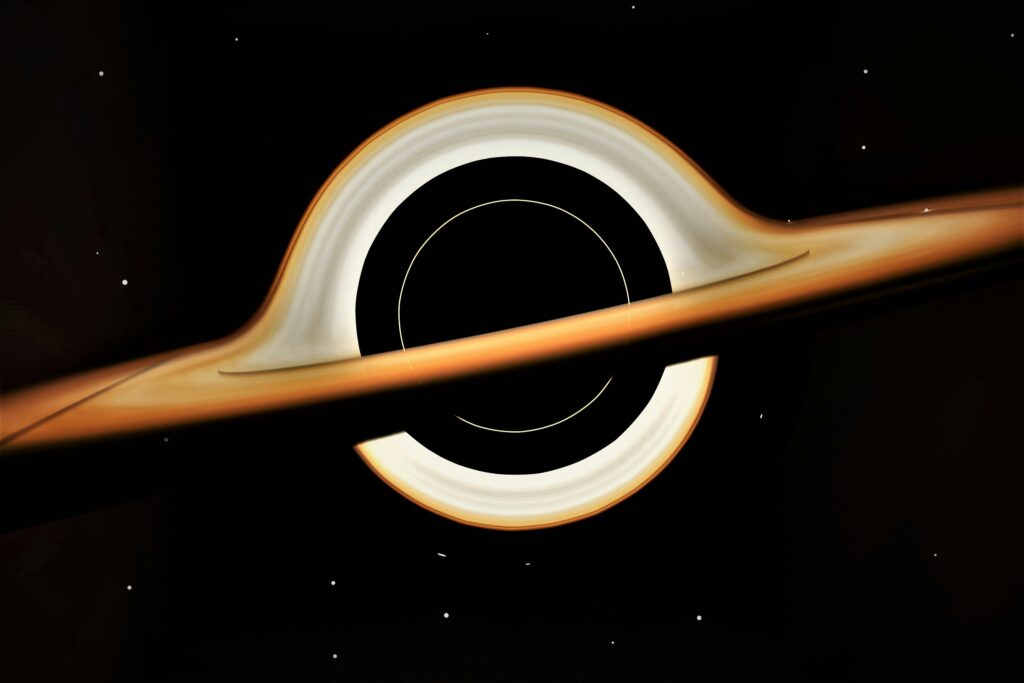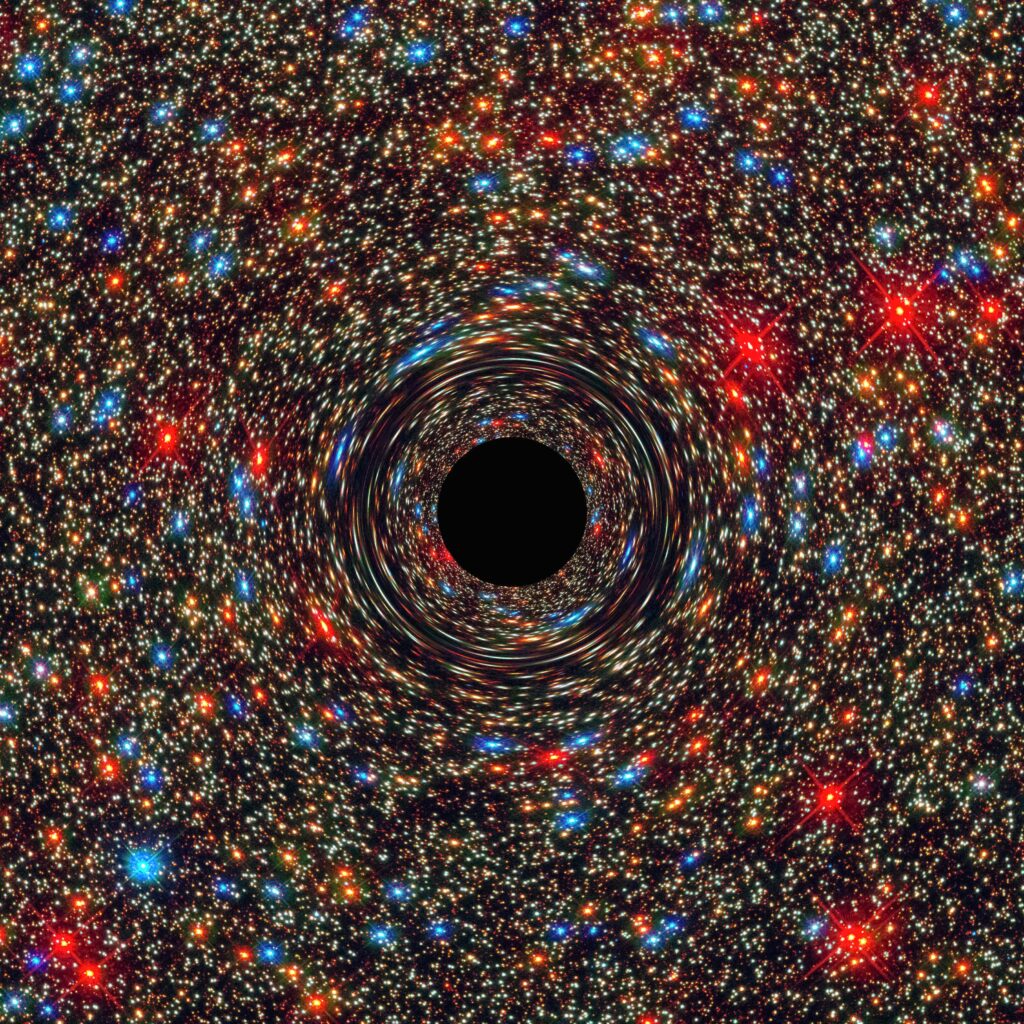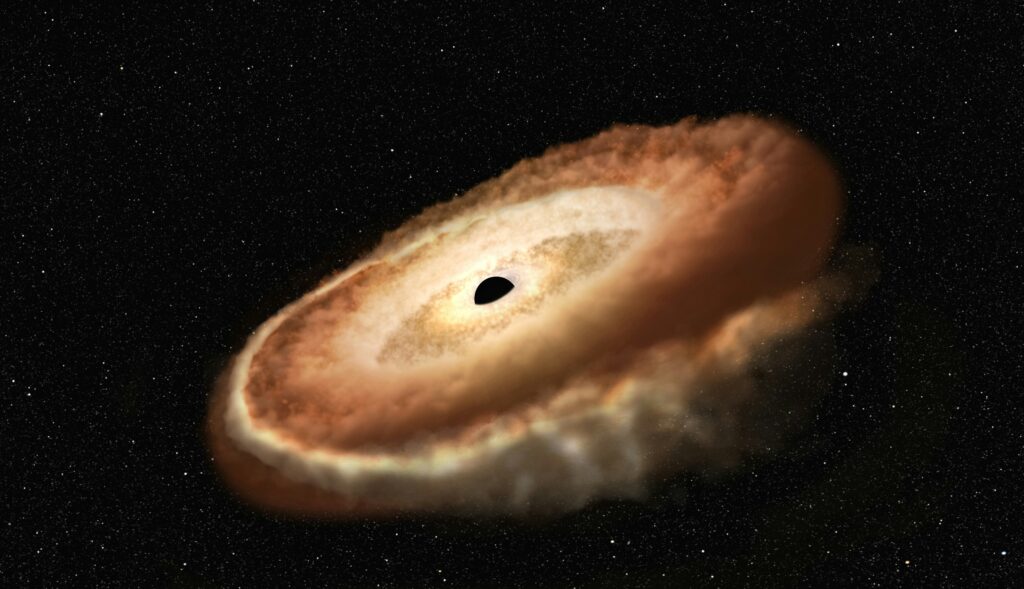A black hole..
is a region of spacetime where gravity is so strong that nothing—no particles or even electromagnetic radiation such as light—can escape from it. The theory of general relativity predicts that a sufficiently compact mass can deform spacetime to form a black hole. The boundary of the region from which no escape is possible is called the event horizon.

What is a Black Hole?
A black hole is a region in space where the gravitational pull is so powerful that it prevents anything, including light, from escaping. This extreme gravity results from an immense amount of mass compressed into an extraordinarily small volume, creating a gravitational field that warps spacetime. According to Albert Einstein’s general theory of relativity (General Relativity), a sufficiently compact mass can form a black hole.
Key Features
- Event Horizon: The boundary around a black hole beyond which nothing can escape. It is not a physical surface but a point of no return, defined by the Schwarzschild radius, which for a black hole 10 times the Sun’s mass is approximately 30 km (Schwarzschild).
- Singularity: At the center lies a point of infinite density and zero volume, where the laws of physics break down. The singularity is hidden within the event horizon, making it inaccessible to direct observation.
- No-Hair Theorem: Black holes are characterized solely by mass, spin, and electric charge, with all other information about the matter that formed them lost (No-Hair Theorem).
Black holes are not “holes” in the traditional sense but dense objects that profoundly affect their surroundings, making them invisible yet detectable through their gravitational influence.
The concept of a body so massive that even light cannot escape dates back to the 18th century, but the modern understanding of black holes began with Albert Einstein’s theory of general relativity in 1915. In 1916, Karl Schwarzschild found the first modern solution to the general relativity equations, which describes a black hole.
The term “black hole” was coined in 1967 by physicist John Archibald Wheeler. Black holes, regions of spacetime with gravitational fields so strong that escape is impossible, are central to modern astrophysics. Predicted by Einstein’s General Theory of Relativity (GR) and observationally confirmed through X-ray binaries, gravitational waves, and direct imaging, black holes challenge our understanding of fundamental physics.
Black holes are among the most enigmatic and captivating objects in the universe. They are regions of spacetime where gravity is so intense that nothing—not even light—can escape. Despite their mysterious nature, black holes are pivotal to our understanding of astrophysics, influencing everything from the life cycles of stars to the evolution of galaxies.
Physical Properties
Black holes exhibit unique physical characteristics governed by general relativity and quantum mechanics:
- Event Horizon: The boundary where the escape velocity equals the speed of light. For a non-rotating black hole, the Schwarzschild radius is given by ( r_s = \frac{2GM}{c^2} \approx 2.95 \frac{M}{M_{\odot}} , \text{km} ).
- Singularity: A point or ring (for rotating black holes) of infinite curvature, where spacetime ceases to be well-defined.
- Photon Sphere: At 1.5 times the Schwarzschild radius, light can orbit the black hole in unstable circular paths.
- Ergosphere: For rotating (Kerr) black holes, a region outside the event horizon where objects cannot remain stationary due to frame-dragging.
- Hawking Radiation: Predicted by Stephen Hawking, black holes emit radiation due to quantum effects near the event horizon, with a temperature inversely proportional to mass (( T = \frac{\hbar c^3}{8 \pi G M k_B} )). For a solar-mass black hole, this is ~62 nanokelvins, making it undetectable (Hawking Radiation).
The no-hair theorem suggests black holes lose all characteristics except mass, spin, and charge, though this is an area of active theoretical debate due to the information paradox.

What is a Black Hole?
Historical Context
The concept of black holes dates back to the 18th century, when John Michell and Pierre-Simon Laplace proposed objects with gravity so strong that light could not escape. In 1916, Karl Schwarzschild provided the first mathematical solution to Einstein’s field equations, describing a non-rotating black hole’s spacetime geometry. David Finkelstein’s 1958 work interpreted black holes as regions from which nothing escapes. The term “black hole” was popularized in the 1960s, and the first confirmed black hole, Cygnus X-1, was identified in 1971 (Cygnus X-1).
Early Theoretical Foundations
- 1783: John Michell proposed “dark stars” with escape velocities exceeding the speed of light.
- 1915: Einstein’s General Relativity equations described gravity as spacetime curvature.
- 1916: Karl Schwarzschild derived the first solution to Einstein’s equations, predicting Schwarzschild radii and singularities.
- 1939: J. Robert Oppenheimer and Hartland Snyder modeled gravitational collapse, hinting at black hole formation.
The Golden Age of Black Hole Theory (1960s–1990s)
- 1967: John Wheeler coined the term “black hole.”
- 1969: Roger Penrose proposed the Penrose singularity theorem, proving black holes form under general relativity.
- 1974: Stephen Hawking theorized Hawking radiation, linking black holes to quantum mechanics.
Observational Breakthroughs (2000s–Present)
- 2019: The Event Horizon Telescope (EHT) captured the first image of M87*, a supermassive black hole.
- 2020: Nobel Prize awarded for discoveries about Sagittarius A*, the Milky Way’s central black hole.
- 2015–2023: LIGO/Virgo detected gravitational waves from merging black holes, confirming their existence.

How Do Black Holes Form?
Black holes form through various processes, primarily the gravitational collapse of massive stars:
Stellar-Mass Black Holes
When a star with a mass at least three times that of the Sun exhausts its nuclear fuel, it can no longer resist its own gravity. The core collapses, often triggering a supernova explosion that expels the outer layers. If the remaining core is sufficiently massive, it collapses into a black hole, compressing to a point of extreme density.
Other Formation Mechanisms
- Direct Collapse: In the early universe, massive gas clouds could collapse directly into black holes, potentially forming supermassive black holes.
- Mergers: Smaller black holes can merge over time, increasing their mass.
- Primordial Black Holes: Hypothetical black holes proposed by Stephen Hawking, possibly formed during the Big Bang due to density fluctuations, with masses as small as asteroids (Hawking).
The exact mechanisms for supermassive black hole formation remain debated, with theories suggesting rapid accretion, mergers, or direct collapse as possible pathways.
Structure of a Black Hole
- Event Horizon: The boundary around a black hole where escape velocity equals the speed of light.
- Singularity: The core of the black hole where matter is thought to be infinitely dense.
- Accretion Disk: The disk of gas and dust that spirals into the black hole.
- Relativistic Jets: High-energy beams of particles that can be ejected from the poles.
Types of Black Holes
Black holes are classified based on their mass, each type playing distinct roles in the universe:
| Class | Approximate Mass | Approximate Radius | Description |
|---|---|---|---|
| Stellar Black Hole | 2–150 M☉ | ~30 km | Formed from massive star collapse, found throughout galaxies. |
| Intermediate-Mass Black Hole | 10²–10⁵ M☉ | ~10³ km (≈ Earth’s radius) | Less common, possibly in globular clusters or dwarf galaxies. |
| Supermassive Black Hole | 10⁶–10⁹ M☉ | 0.001–400 AU | Located at galaxy centers, powering quasars and active galactic nuclei (AGN). |
| Ultra-massive Black Hole | 10⁹–10¹¹ M☉ | >1,000 AU | Rare, found in massive galaxies, e.g., NGC 3842. |
| Micro Black Hole | Up to Moon’s mass | Up to 0.1 mm | Hypothetical, possibly primordial, not yet observed. |
- Stellar-Mass Black Holes: Examples include Cygnus X-1, with a mass of 14.8 solar masses.
- Supermassive Black Holes: Sagittarius A* at the Milky Way’s center has a mass of ~4.3 million solar masses (Sagittarius A*), while M87’s black hole has ~6.5 billion solar masses (M87).
- Intermediate-Mass Black Holes: Evidence is emerging, with candidates detected via gravitational waves (LIGO).
- Primordial Black Holes: Theoretical, potentially contributing to dark matter, but no direct evidence exists.
Detecting Black Holes
Black holes are invisible, but their presence is inferred through their gravitational and radiative effects:
Gravitational Effects
- Stellar Orbits: The motion of stars around an unseen massive object indicates a black hole. Observations of stars orbiting Sagittarius A* confirmed its mass and size (Nobel Prize 2020).
- Gravitational Lensing: Black holes bend light from distant objects, creating distorted images or multiple images, used to detect isolated black holes (Microlensing).
Accretion Disks
- Matter falling into a black hole forms an accretion disk, heating up and emitting X-rays, radio waves, or other radiation. This is observed in X-ray binaries like Cygnus X-1 and quasars powered by supermassive black holes.
- Example: The quasar associated with J0529-4351, the fastest-growing black hole, is 500 trillion times brighter than the Sun (Nature Astronomy).
Direct Imaging
- The Event Horizon Telescope (EHT) captured the first image of a black hole in M87 on April 10, 2019, showing a bright ring of light around the event horizon (EHT M87). Sagittarius A* was imaged on May 12, 2022 (EHT Sgr A*).
Gravitational Waves
- Mergers of black holes produce gravitational waves, ripples in spacetime detected by LIGO and Virgo. The first detection, GW150914, on September 14, 2015, involved two black holes (29 and 36 solar masses) merging 1.3 billion light-years away to form a 62-solar-mass black hole (GW150914).
Black Holes and Gravitational Waves
Gravitational waves are a revolutionary tool for studying black holes. When two black holes orbit each other, they lose energy through gravitational waves, causing their orbits to decay until they merge. This process releases tremendous energy, detectable on Earth.
- First Detection: GW150914 confirmed the existence of binary black hole systems and tested general relativity in extreme conditions.
- Subsequent Detections: Over ten binary black hole mergers have been observed, with events like GW190521 suggesting a resulting black hole of ~142–250 solar masses, challenging formation theories (GW190521).
- Significance: Gravitational waves provide insights into black hole masses, spins, and merger rates, helping map the population of black holes in the universe.
The Role of Black Holes in the Universe
Supermassive black holes are central to galaxy evolution:
- Central Location: Nearly all massive galaxies host supermassive black holes, with masses correlating to the galaxy’s bulge mass, suggesting co-evolution (JAXA).
- Energy Release: Accretion onto black holes powers quasars and AGN, releasing energy that can exceed 100 times that of nuclear fusion (Nature).
- Feedback Mechanisms: A fraction of this energy heats or ejects gas, suppressing star formation. This is thought to explain why elliptical galaxies have less star formation than spirals (Harvard CfA).
- Controversy: While feedback is widely accepted, the extent of its impact is debated, with some models suggesting alternative processes like gas depletion play a larger role.
Black holes also serve as laboratories for testing fundamental physics, including general relativity and quantum mechanics, particularly through phenomena like Hawking radiation and the information paradox.
Theoretical Concepts
Hawking Radiation
Proposed by Stephen Hawking in 1974, it suggests that black holes can emit radiation due to quantum effects near the event horizon.
Information Paradox
A major puzzle in theoretical physics: does information that falls into a black hole get destroyed?
Wormholes
Hypothetical tunnels through spacetime, possibly connecting distant parts of the universe or different universes. Some theories link them to black holes.
Famous Black Holes
- Cygnus X-1: A stellar-mass black hole (~14.8 solar masses) in a binary system, discovered in 1971.
- Sagittarius A*: The Milky Way’s supermassive black hole (~4.3 million solar masses), studied through stellar orbits.
- M87*: A supermassive black hole (~6.5 billion solar masses), imaged by EHT, located 55 million light-years away.
- J0529-4351: The fastest-growing black hole, with a mass of 17–19 billion solar masses, accreting at 40 times the Eddington limit (Fastest-Growing Black Hole).
Myths and Misconceptions
- Black Holes as Cosmic Vacuum Cleaners: Black holes only exert strong gravity close to the event horizon. From a distance, their gravitational pull is similar to any object of the same mass (NASA).
- Black Holes as Wormholes: Black holes are not shortcuts to other parts of the universe or dimensions, despite popular depictions in science fiction.
- Black Holes Destroy Everything: Only objects crossing the event horizon are lost; black holes can coexist with orbiting stars and gas.8. Recent Developments
- First Image of a Black Hole (2019): Captured by the Event Horizon Telescope (EHT) showing the shadow of the black hole in M87.
- Nobel Prize in Physics (2020): Awarded to Roger Penrose, Reinhard Genzel, and Andrea Ghez for their work on black holes.
Recent Developments
- First Image of a Black Hole (2019): Captured by the Event Horizon Telescope (EHT) showing the shadow of the black hole in M87.
- Nobel Prize in Physics (2020): Awarded to Roger Penrose, Reinhard Genzel, and Andrea Ghez for their work on black holes.
Future of Black Hole Research
Black hole research is advancing rapidly:
- Event Horizon Telescope: Continues to refine images of black holes, exploring magnetic fields and accretion dynamics (EHT).
- Gravitational Wave Observatories: LIGO, Virgo, and future missions like LISA will detect a broader range of black hole mergers (LIGO).
- Theoretical Advances: Studies of Hawking radiation, the information paradox, and quantum gravity aim to reconcile general relativity with quantum mechanics.
- Multi-Messenger Astronomy: Combining gravitational waves with electromagnetic observations (e.g., X-rays, radio) will provide a fuller picture of black hole environments (Universe Today).
Black holes are not merely cosmic curiosities but fundamental to our understanding of the universe. From their formation in stellar collapses to their role in shaping galaxies, they challenge our grasp of physics and inspire awe. As observational technologies and theoretical models advance, black holes continue to reveal the intricate interplay of gravity, matter, and spacetime, cementing their place as one of astronomy’s most compelling subjects. Black holes are among the most fascinating and mysterious objects in the universe. They challenge our understanding of physics and continue to be a focus of astronomical and theoretical research. As observational technologies improve, we may uncover deeper truths about these enigmatic entities and their role in the cosmos.
Some References
- Einstein, A. (1915). General Theory of Relativity.
- Hawking, S. W. (1974). Black Hole Explosions? Nature, 248(5443), 30–31.
- Event Horizon Telescope Collaboration (2019). First M87 black hole image. First M87 Event Horizon Telescope Results. The Astrophysical Journal Letters, 875(1).
- NASA, ESA – Various mission data.
- Kip Thorne, Black Holes and Time Warps.
- Thorne, K. S. (1994). Black Holes and Time Warps: Einstein’s Outrageous Legacy. W. W. Norton.
- Abbott, B. P., et al. (2016). Observation of Gravitational Waves from a Binary Black Hole Merger. Physical Review Letters, 116(6).
Some books for deep understanding.
“A Brief History of Time” by Stephen Hawking
Amazon Link: Buy on Amazon Flipkart Link: Buy on Flipkart
Black Holes and Time Warps: Einstein’s Outrageous Legacy by Kip Thorne
buy on Amazon: Link buy on Flipkart: Link
The Theory of Everything: The Origin and Fate of the Universe by Stephen Hawking
buy on Amazon: Link buy on Flipkart: Link
Death by Black Hole: And Other Cosmic Quandaries by Neil deGrasse Tyson
The Black Hole War: My Battle with Stephen Hawking to Make the World Safe for Quantum Mechanics by Leonard Susskind
Black Hole Blues and Other Songs from Outer Space by Janna Levin
Gravity’s Fatal Attraction: Black Holes in the Universe by Mitchell Begelman and Martin Rees













